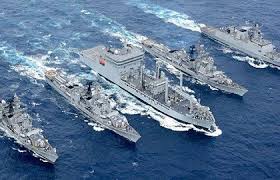
H1: Introduction
- Overview of India’s strategic move to bolster maritime security.
- Rising concerns over China’s increasing presence in the Indian Ocean.
H2: Importance of the Indian Ocean in Global Trade and Security
- Significance of the Indian Ocean in international shipping routes.
- The role of the Indian Ocean in regional stability and geopolitics.
H2: India’s Recent Naval Launches
- Overview of the three new vessels: INS Vagsheer submarine, a destroyer, and a frigate.
- Role of state-run shipyards in India’s defense manufacturing.
H3: INS Vagsheer Submarine
- Features and capabilities of the Scorpene-class submarine.
- How INS Vagsheer bridges India’s naval capability gaps.
H3: The Newly Launched Destroyer
- Advanced features of the destroyer.
- Strategic implications for India’s maritime strength.
H3: The Newly Launched Frigate
- Key functionalities and its role in naval operations.
- Enhancing India’s blue-water navy capabilities.
H2: China’s Growing Presence in the Indian Ocean
- Overview of Chinese naval activities in the region.
- Concerns raised by India and other nations.
H3: China’s Belt and Road Initiative (BRI)
- Influence of the BRI on the Indian Ocean region.
- Maritime Silk Road and its implications.
H3: Chinese Naval Bases and Surveillance
- Development of Chinese bases like Djibouti.
- Increased naval surveillance in critical maritime chokepoints.
H2: India’s Response to Chinese Expansion
- Strengthening maritime domain awareness (MDA).
- Collaborations with international allies like the US, Japan, and Australia.
H3: Quad Partnership
- Role of the Quad in maintaining regional security.
- Joint naval exercises and strategic alignments.
H3: Indigenous Defense Manufacturing
- India’s push for self-reliance in defense.
- The role of Make in India in modernizing naval capabilities.
H2: Strategic Implications of India’s Naval Enhancements
- Impact on regional power dynamics.
- Enhancing India’s deterrence against potential threats.
H2: Future of India’s Maritime Strategy
- Planned developments in India’s naval fleet.
- Focus on securing trade routes and countering emerging threats.
H2: Conclusion
- Summary of India’s proactive measures.
- The significance of these steps for regional and global maritime security.
H2: FAQs
- Why is the Indian Ocean strategically important?
- What are the features of INS Vagsheer?
- How is China expanding its influence in the Indian Ocean?
- What role does the Quad play in the region?
- What is India’s vision for maritime security?
Naval Enhancements in the Indian Ocean: Strengthening India’s Maritime Security
Introduction
India has taken a monumental step to fortify its maritime security by launching three cutting-edge naval vessels—a submarine, a destroyer, and a frigate. These additions are part of India’s broader strategy to address the growing security challenges in the Indian Ocean region (IOR), particularly in light of China’s increasing influence. Defense Minister Rajnath Singh and Prime Minister Narendra Modi emphasized the strategic importance of this move, calling it a milestone in India’s defense manufacturing and maritime strength.
Importance of the Indian Ocean in Global Trade and Security
The Indian Ocean serves as a lifeline for global trade, with nearly 80% of the world’s maritime oil trade passing through its waters. Home to critical chokepoints like the Strait of Hormuz, Malacca Strait, and Bab-el-Mandeb, this region holds immense geopolitical importance.
For India, the Indian Ocean is more than just a trade route—it’s a gateway to regional dominance and security. As the third-largest ocean, it connects Asia, Africa, and Australia, making it a hub for international commerce and a focal point for emerging maritime challenges.
India’s Recent Naval Launches
To counter evolving threats and enhance maritime security, India recently launched three advanced naval vessels from a state-run shipyard. This significant development underscores India’s commitment to modernizing its navy and reducing dependence on foreign defense imports.
INS Vagsheer Submarine
The INS Vagsheer, the sixth Scorpene-class submarine, represents a leap forward in India’s underwater capabilities. Built with French collaboration under Project-75, this diesel-electric submarine is designed for stealth, surveillance, and attack missions. With features like advanced sonar systems, torpedo capabilities, and the ability to remain undetected for extended periods, INS Vagsheer is a formidable addition to India’s naval arsenal.
This submarine addresses critical capability gaps in India’s fleet, especially as neighboring nations ramp up their underwater assets.
The Newly Launched Destroyer
India’s latest destroyer is a technological marvel equipped with advanced radar systems, long-range missiles, and superior combat systems. Designed to counter both surface and aerial threats, this vessel enhances India’s ability to project power across the Indian Ocean and beyond.
The Newly Launched Frigate
Frigates are the workhorses of any navy, and India’s newest addition is no exception. With multi-role capabilities, including anti-submarine warfare, surface warfare, and air defense, this frigate strengthens India’s operational flexibility in high-stakes situations.
China’s Growing Presence in the Indian Ocean
China’s increasing foray into the Indian Ocean has raised alarms across the globe. From deploying warships to establishing naval bases, China’s activities signal its intent to dominate the region.
China’s Belt and Road Initiative (BRI)
China’s Belt and Road Initiative, particularly its Maritime Silk Road, has extended its influence into the Indian Ocean. By investing in port infrastructure across Sri Lanka, Pakistan, and the Maldives, China has created a network that could potentially double as a military supply chain.
Chinese Naval Bases and Surveillance
The establishment of a Chinese naval base in Djibouti and the frequent deployment of surveillance ships in the Indian Ocean indicate a long-term strategy to monitor and control key maritime routes.
India’s Response to Chinese Expansion
India has adopted a multi-pronged approach to counter China’s growing influence in the Indian Ocean.
Quad Partnership
India’s collaboration with the Quad (comprising the US, Japan, and Australia) has emerged as a cornerstone of its maritime strategy. Joint naval exercises like Malabar strengthen interoperability among the member nations, sending a strong message of unity against coercive tactics in the region.
Indigenous Defense Manufacturing
India’s push for self-reliance in defense is paying dividends. Initiatives like “Make in India” have not only modernized the navy but also reduced dependency on foreign suppliers, ensuring a robust and self-sufficient defense ecosystem.
Strategic Implications of India’s Naval Enhancements
The launch of these advanced vessels is a game-changer for India’s maritime strategy. It boosts India’s deterrence capabilities, strengthens its role as a net security provider in the Indian Ocean, and signals its readiness to counter any regional threats.
Future of India’s Maritime Strategy
Looking ahead, India plans to expand its naval fleet further, focusing on aircraft carriers, nuclear submarines, and advanced frigates. With an eye on securing trade routes and enhancing maritime domain awareness, India is well-positioned to lead the way in ensuring stability in the Indian Ocean region.
Conclusion
India’s recent naval advancements mark a pivotal moment in its maritime journey. By launching INS Vagsheer, a destroyer, and a frigate, India has demonstrated its resolve to safeguard its interests in the Indian Ocean. As the region becomes increasingly contested, these steps not only bolster India’s defense but also contribute to the broader goal of regional security and stability.
FAQs
Why is the Indian Ocean strategically important?
The Indian Ocean is crucial for global trade, with major shipping routes and energy supplies passing through its waters.What are the features of INS Vagsheer?
INS Vagsheer is a Scorpene-class submarine equipped with advanced stealth, sonar, and torpedo systems, ideal for diverse naval missions.How is China expanding its influence in the Indian Ocean?
Through initiatives like the BRI, port investments, and naval bases, China is steadily increasing its footprint in the region.What role does the Quad play in the region?
The Quad enhances regional security through joint exercises, interoperability, and a shared commitment to a free and open Indo-Pacific.What is India’s vision for maritime security?
India aims to modernize its navy, secure trade routes, and maintain regional stability through indigenous defense manufacturing and strategic alliances.








